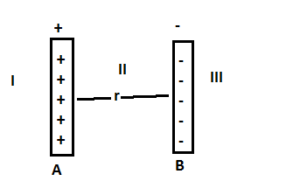Case study question of Physics – Electric charges and field
Case study 5:- Surface charge density is defined as charge per unit surface area of surface charge distribution i.e., σ = dq/ds. Two large thin metal plates are parallel and close to each other. On their inner faces, the plates have surface charge densities of opposite sign having magnitude of ![]() C/m² as shown. The intensity of electric field at a point is
C/m² as shown. The intensity of electric field at a point is ![]() , where
, where ![]() permittivity of free space.
permittivity of free space.

Read the given passage carefully and give the answer of the following questions:
Q 1:- What is the value of E in the outer region of the first plate ?
Q 2:- What is the value of E in the outer region of the second plate ?
Q 3:- What will be the value of E between the plates ?
Q 4:- What is the ratio of E from right side of b at distance of 2 cm and 4 cm, respectively ?
Q 5:- In order to estimate the electric field due to a thin finite plane metal plate, what is the shape of the Gaussian surface ?
Answer :- 1. There are two plates A and b having surface charge densities, ![]() C/m² on B. respectively.
C/m² on B. respectively.

According to the Gauss’s theorem, if the plates have same surface charge density but having opposite sign, then the electric field in region is zero.
![]()
2. The electric field in region III is also zero.
![]()
3. In region II or between the plates, the electric field
![]()
![]()
![]() N/C
N/C
4. Electric field due to an infinite plane sheet of charge does not depend on the distance of observation point from the plane sheet of charge.
so, ratio of E will be 1:1.
5. We take a cylindrical cross-section area A and length 2r as Gaussian surface.
Case study 1:- A charge is a property associated with the matter due to which it experiences and produces an electric and magnetic fields. Charges are scalar in nature and they add up like real numbers. Also, the total charge of an isolated system is always conserved. When the objects rub against each other, charges acquired by them must be equal and opposite.
Read the given passage carefully and give the answer of the following questions:
Q 1:- The cause of charging is:
(a) The actual transfer of protons
(b) The actual transfer of electrons
(c) The actual transfer of neutrons
(d) None of the above
Answer :- See all answer
Case study 2:- Coulamb’s law states that the electrostatic force of attraction or repulsion acting between two stationary points charges is given by
![]()
Where F denotes the force between two charges ![]() and
and ![]() separated by a distance r in free space,
separated by a distance r in free space, ![]() is a constant known as permittivity of free space. Free space is vacuum and may be taken to be air practically.
is a constant known as permittivity of free space. Free space is vacuum and may be taken to be air practically.
If free space is replaced by a medium, then ![]() is repaced by
is repaced by ![]() or
or ![]() , where k is known as dielectric constant or relative permittivity.
, where k is known as dielectric constant or relative permittivity.
Read the given passage carefully and give the answer of the following questions:
Q 1:- In coulamb’s law, ![]() , then on which of the following factors does the proportionality constant k depends ?
, then on which of the following factors does the proportionality constant k depends ?
(a) Electrostatic force acting between the two charge
(b) Nature of the medium between the two charges
(c) Magnitude of the two charges
(d) Distance between the two charges
Answer :- See the answer
Case study 3:- Animals emit low frequency electric fields due to a process known as osmoregulation. This process allows the concentration of ions (charged atoms or molecules) to flow between the inside of our bodies and the outside. In order for our cells to stay intact, the flow of ions needs to be balanced. But balanced doesn’t necessarily mean equal. The concentration of ions within a shrimp’s body is much lower than that of the sea water it swims in. Their voltage or potential sifference generated between the two concentrations across ‘leaky’ surfaces, can then be measured.
Read the given passage carefully and give the answer of the following questions:
Solution:- See full solution
Case study 4:- When electric dipole is placed in uniform electric field, its two charges experience equal and opposite forces, which cancel each other and hence net forceon electric dipole in uniform electric field is zero. However, these forces are not collinear, so they give rise to some torque on the dipole. Since, net force on electric dipole in uniform electric field is zero, so no work is done in moving the electric dipole in uniform electric field. However, some work is done in rotating the dipole against the torque acting on it.
Read the given passage carefully and give the answer of the following questions:
Q 1:- The dipole moment of a dipole in a uniform external field ![]() is
is ![]() . What will be the torque
. What will be the torque ![]() acting on the dipole ?
acting on the dipole ?
Solution :- See full solution